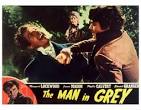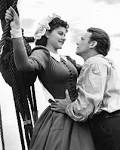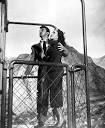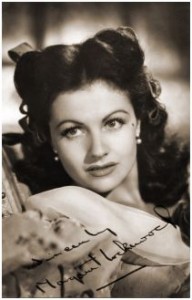The Man in Grey **** (1943, Margaret Lockwood, James Mason, Stewart Granger, Phyllis Calvert) – Classic Movie Review 1336
The famous 1943 Gainsborough melodrama The Man in Grey showcases the studio’s four biggest stars Margaret Lockwood, Phyllis Calvert, James Mason and Stewart Granger to great advantage.
Co-writer/director Leslie Arliss’s famous 1943 Gainsborough melodrama showcases the studio’s two biggest female stars Margaret Lockwood and Phyllis Calvert alongside their two biggest male stars James Mason and Stewart Granger to great advantage. The film was a massive hit in the UK, turning the four leading actors into world-class stars.
In the story based on a once-popular novel by Lady Eleanor Smith, Regency schoolgirls become bosom buddies when sweet, rich and pretty Clarissa Richmond (Calvert) looks after bitter, poor Hesther Snow (Lockwood).
But Hesther eventually returns the favour by seducing Clarissa’s handsome and hedonistic but brutish and horrible husband, the Marquis of Rohan (Mason). Rohan has just married Clarissa as a breeding mare, and happily begins an affair with her friend Hesther, who plots to take her place.
The movie starts at an estate auction in World War Two England in 1943, when two strangers, a WREN (Calvert) and an RAF pilot (Granger), meet at an auction of Rohan family heirlooms being sold off after the last of the male line was killed at Dunkirk. They start to muse about their families’ history and connections. Cue flashbacks…
Arliss’s great fun, campy bodice-ripping yarn is still wonderfully pleasurable, thanks to the florid story, the exuberant handling and the ideal stars, who are on top sneering, leering and weeping form.
The Man in Grey is the pioneering first film in a series of hit period costume dramas known and remembered affectionately as the ‘Gainsborough melodramas’, which merged the women’s picture genre with new melodramatic elements – lust, sex, and violence. This quintessential British costume drama set the tone for a whole host of flamboyantly escapist Gainsborough Pictures films to come, especially The Wicked Lady (1945), also with the team of Lockwood and Mason.
The ‘Gainsborough melodramas’ proved just the right kind of thing to distract and divert wartime audiences. In 1946 readers of the Daily Mail voted it their second most favourite British film of 1939–45 after The Way to the Stars. Their favourite leading actor and actress in British films were Mason and Lockwood.
However, James Mason later described his performance as “atrocious”
Helen Haye, Nora Swinburne, Raymond Lovell, Martita Hunt, Amy Veness, Diana King, Beatrice Varley, Patrick Curwen and A E Mathews co-star.
It is a satisfyingly long saga at 116 minutes but the US version runs only 93 minutes, released there by Universal, but it was not as popular in the US.
It is produced by Edward Black from a screenplay by Arliss and Margaret Kennedy, adapted by Doreen Montgomery from the 1941 novel The Man in Grey by English writer Lady Eleanor Smith (7 August 1902 – 20 October 1945), a member of the Bright Young Things, a group of Bohemian young aristocrats and socialites in 1920s London. The Man in Grey was published in 1941 and became a best seller in the US, selling more than 100,000 copies in 1942. Another one of her novels, Caravan, published in 1942, was filmed by Gainsborough Pictures as Caravan after her death. One the Gainsborough melodramas, it stars Stewart Granger, Jean Kent, Anne Crawford and Dennis Price.
The sets are designed by Walter Murton.
Phyllis Calvert, who was pregnant during filming, later said Leslie Arliss was ‘not at all’ responsible for the film’s success. She recalled: ‘He was a lazy director. He had got a wonderful job there and he just sat back. Producer Edward Black was the one who would watch it, cut it, and know exactly what the audience would take. I don’t say he wanted to do really good films, but he knew where the money was and he made all those escapist films during the war.’ Calvert said that on one occasion Arliss was late for a scene with Calvert and Granger, so they directed it themselves, and ‘Arlissing about’ became a ‘Gainsborough byword for slackness.’
Lockwood, the only one of the four leads already a star, said at the time: ‘It is a part Hollywood would have given to a star like Bette Davis. Its Regency settings are away from the war. It has plenty of emotional, dramatic quality, yet it calls for subtlety. It is a role I can handle well under English direction, for British studios don’t concentrate on glamorising stars to such an extent that they become camera-conscious, thinking only of whether they are at the right angle to the camera.’
But she later revealed that she thought she would be ideal as Clarissa and was not pleased to be cast as Hesther. ‘True, I had played that unpleasant little piece in The Stars Look Down after many misgivings. But Hesther was a different matter. She was downright wicked.’ Lockwood didn’t like the character’s motivation but it was a ‘meaty’ part.
Granger was the last of the leads to be cast and was paid £1,000 for 12 weeks work. He recalled: ‘I’d have played the part for nothing, it was such a chance.’
The cast are Margaret Lockwood as Hesther, Phyllis Calvert as Clarissa (19th century, and present day), James Mason as Lord Rohan, Stewart Granger as Rokeby (19th century, and present day), Antony Scott [Harry Scott] as Toby, Martita Hunt as Miss Patchett, Helen Haye as Lady Rohan, Beatrice Varley as Gipsy, Raymond Lovell as The Prince Regent, Nora Swinburne as Mrs Fitzherbert, Amy Veness, Diana King, Patrick Curwen and A E Mathews.
http://derekwinnert.com/the-wicked-lady-margaret-lockwood-james-mason-classic-movie-review-1335/
© Derek Winnert 2014 Classic Movie Review 1336
Link to Derek Winnert’s home page for more film reviews: http://derekwinnert.com/















